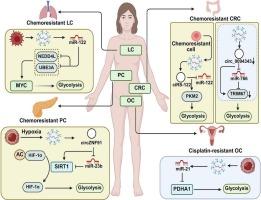非编码rna -糖酵解轴在癌症治疗耐药中的作用:对治疗方案机制的洞察。
IF 5.6
2区 医学
Q1 PHARMACOLOGY & PHARMACY
引用次数: 0
摘要
尽管包括放疗和化疗在内的癌症治疗取得了进展,但对癌症治疗的耐药性仍然是一个重大的临床挑战。代谢重编程和功能失调的糖酵解是癌细胞的一个决定性特征,在耐药癌细胞中经常观察到。除糖酵解酶外,包括EGFR、HIF-1α、AMPK和β-catenin在内的一些信号分子也参与糖酵解的调控,并在介导癌症治疗耐药中发挥关键作用。大量研究已经阐明了非编码rna (ncRNAs),特别是microRNAs (miRNAs)、长链非编码rna (lncRNAs)和环状rna (circRNAs)在癌症耐药调控中的关键作用。mirna对糖酵解具有双重调控作用——一些抑制糖酵解以克服治疗耐药性,而另一些则促进糖酵解,诱导癌细胞产生耐药性。最近的研究强调了竞争性内源性rna (ceRNAs)在调节糖酵解途径中的关键功能,表明circRNA/lncRNA-miRNA-mRNA是癌症治疗耐药的重要调控网络。外泌体ncrna是癌症治疗耐药的另一介质;根据它们携带的特定ncrna,它们可以促进或抑制糖酵解。在最后一节中,我们证明了草药可以通过调节ncrna -糖酵解轴成功减轻癌症的耐药。本文章由计算机程序翻译,如有差异,请以英文原文为准。

Non-coding RNAs-glycolysis axis in cancer therapy resistance: Insight into mechanism to therapeutic solution
Despite advancements in cancer therapy, including radiotherapy and chemotherapy, resistance to cancer treatment remains a significant clinical challenge. Metabolic reprogramming and dysfunctional glycolysis, a defining characteristic of cancer cells, are commonly observed in drug-resistant cancer cells. Besides glycolytic enzymes, several signaling molecules—including EGFR, HIF-1α, AMPK, and β-catenin—are involved in the regulation of glycolysis and play crucial roles in mediating resistance to cancer therapy. Numerous studies have elucidated the pivotal role of non-coding RNAs (ncRNAs), particularly microRNAs (miRNAs), long non-coding RNAs (lncRNAs), and circular RNAs (circRNAs), in the modulation of cancer drug resistance. miRNAs dually regulate glycolysis—some inhibit glycolysis to overcome therapy resistance, while others promote glycolysis, inducing resistance in cancer cells. Recent investigations have underscored the critical function of competitive endogenous RNAs (ceRNAs) in modulating glycolytic pathways, indicating circRNA/lncRNA–miRNA–mRNA as an important regulatory network in cancer therapy resistance. Exosomal ncRNAs are another mediator of cancer therapy resistance; depending on the specific ncRNAs they carry, they can either promote or suppress glycolysis. In the final section, we demonstrated that herbal medicine can successfully mitigate drug resistance in cancer by modulating the ncRNA-glycolysis axis.
求助全文
通过发布文献求助,成功后即可免费获取论文全文。
去求助
来源期刊

Biochemical pharmacology
医学-药学
CiteScore
10.30
自引率
1.70%
发文量
420
审稿时长
17 days
期刊介绍:
Biochemical Pharmacology publishes original research findings, Commentaries and review articles related to the elucidation of cellular and tissue function(s) at the biochemical and molecular levels, the modification of cellular phenotype(s) by genetic, transcriptional/translational or drug/compound-induced modifications, as well as the pharmacodynamics and pharmacokinetics of xenobiotics and drugs, the latter including both small molecules and biologics.
The journal''s target audience includes scientists engaged in the identification and study of the mechanisms of action of xenobiotics, biologics and drugs and in the drug discovery and development process.
All areas of cellular biology and cellular, tissue/organ and whole animal pharmacology fall within the scope of the journal. Drug classes covered include anti-infectives, anti-inflammatory agents, chemotherapeutics, cardiovascular, endocrinological, immunological, metabolic, neurological and psychiatric drugs, as well as research on drug metabolism and kinetics. While medicinal chemistry is a topic of complimentary interest, manuscripts in this area must contain sufficient biological data to characterize pharmacologically the compounds reported. Submissions describing work focused predominately on chemical synthesis and molecular modeling will not be considered for review.
While particular emphasis is placed on reporting the results of molecular and biochemical studies, research involving the use of tissue and animal models of human pathophysiology and toxicology is of interest to the extent that it helps define drug mechanisms of action, safety and efficacy.
 求助内容:
求助内容: 应助结果提醒方式:
应助结果提醒方式:


